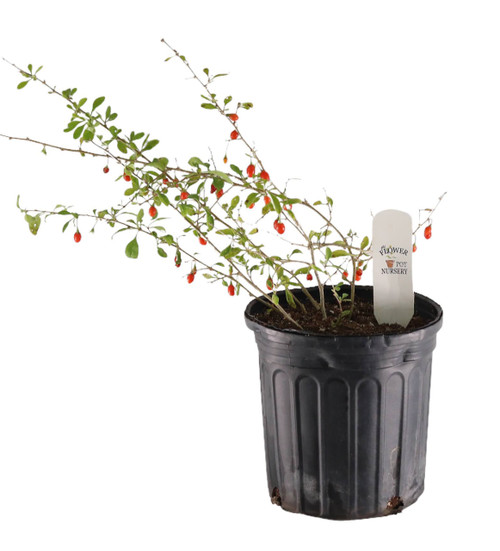Lycium barbarum is a shrub native to China, with present-day range across Asia and southeast Europe. It is one of two species of boxthorn in the family Solanaceae from which the goji berry or wolfberry is harvested, the other being Lycium chinense.
Common names of the plant in English include Chinese wolfberry, barbary matrimony vine, red medlar or matrimony vine. In the United Kingdom it is also known as Duke of Argyll's tea tree after Archibald Campbell, 3rd Duke of Argyll who introduced it in the country in the 1730s.
The shrub is an important commercial crop in northern China, especially in the Ningxia Hui Autonomous Region. Its Chinese name is Ningxia gǒuqǐ.
Lycium barbarum is a deciduous woody shrub, growing 1-3 metres (3 ft 3 in - 9 ft 10 in) high. The shrub has weak arching branches, and the side branches are often reduced to short leafless spines.
L. barbarum leaves form on the shoot either in an alternating arrangement, or in bundles of up to three. Each leaf is green, scarcely fleshy when fresh, usually lanceolate (spearhead-shaped), sometimes with rounded tips. Clustered leaves are up to 25 mm long; the single alternate leaves are up to 55 mm long.
The flowers grow in groups of one to three in the leaf axils, with pedicels 6-15 mm long. The calyx, eventually ruptured by the growing berry, is a whitish tube crowned by five or six radial triangular sepals, shorter than the tube, 10-12 mm long and 3-4 mm wide, sometimes 2-lipped, strongly curved. The sepals are whitish on the lower side (facing towards the branch) and deep mauve on the top side. Each flower has five stamens, exserted for 3-8 mm, with stalks longer than the anthers. The pistil is 8-11.5 mm long. The anthers are longitudinally dehiscent.
The fruit of L. barbarum, the main variety of goji berry, is a bright orange-red, ellipsoid berry 1-2 cm (0.39-0.79 in) in diameter. The fruiting calyx is split deeply once or twice. The number of seeds in each berry varies widely based on cultivar and fruit size, ranging from 10 to 60. The seeds are about 2 mm long, 1 mm wide, yellowish, compressed with a curved embryo.
In the Northern Hemisphere, flowering occurs from June through September and berry maturation from August to October, depending on the latitude, altitude, and climate. Where frost does not occur fruiting is continuous and plants do not lose their leaves.
Give credit where credit is due: Wikipedia 2022
FlowerPotNursery Super Fruit Goji Berry Lycium barbarum 1 Gallon Pot
The Flower Pot Nursery
$13.99
- SKU:
- GBLB1G1022














